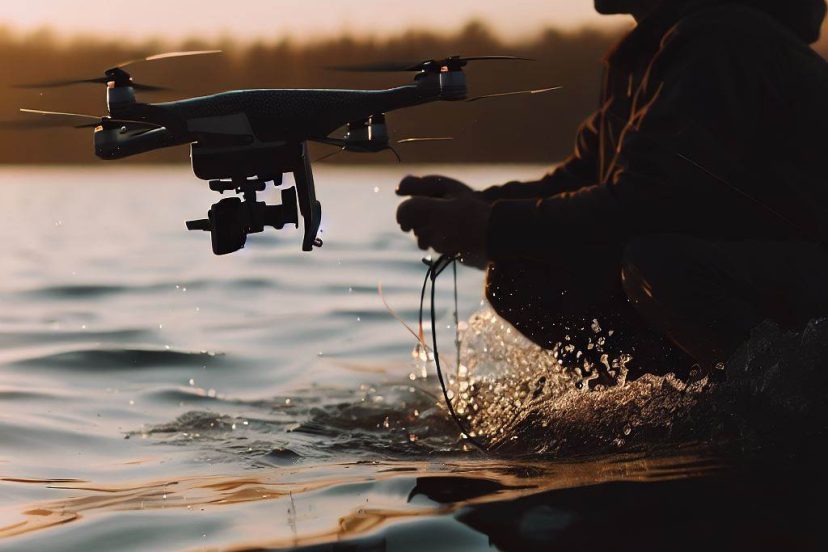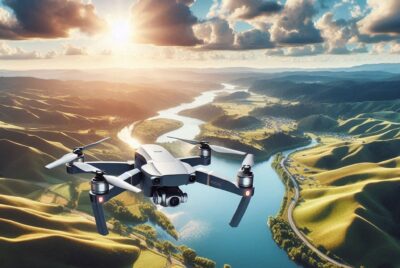Fishing Drone: Revolutionizing Angling Adventures
*We may earn a commission for purchases made using our links. Please see our disclosure to learn more.
Fishing Drone Advancements: Revolutionizing Angling
Fishing has evolved significantly with technological advancements, and one such cutting-edge tool is the fishing drone. Unlike traditional fishing methods, drones offer a unique vantage point and can transport bait to otherwise inaccessible areas. With GPS technology, these drones can also scout for schools of fish, providing anglers with a strategic edge in both freshwater and saltwater environments. The integration of sophisticated camera systems allows for precise drops and real-time viewing, transforming the fishing experience completely.
When considering a fishing drone, potential buyers should prioritize features such as payload capacity, range, battery life, and waterproofing. Since these drones are designed to operate near or on water bodies, durability against water exposure is critical. Furthermore, the drone’s lifting ability is paramount to transport bait and potentially catch fish, which requires strength and stability.
Customers should also contemplate the ease of use and the learning curve associated with the drone’s controls. Some models come with autopilot functions and pre-programmed routes, which can be particularly advantageous for novices or solo fishermen. Considering these attributes will ensure that the chosen drone meets the personal needs of the user and enriches their fishing activities.
Given my extensive research and hands-on testing with various models, I have honed in on the nuances that delineate a reliable fishing drone from an inferior one. In the following section, I will detail my findings, helping you discern which fishing drone aligns with your outdoor pursuits and brings efficiency to your angling arsenal.
Top Fishing Drone Selections to Enhance Your Angling Experience
In my extensive search for tools that add value to fishing adventures, I have come across several drones specifically designed for the angler in mind. My selection criteria focus on their ability to withstand harsh marine environments, the quality of on-board cameras, flight stability, and how well they can assist in scouting and dropping bait. What follows is a curated list of the best fishing drones that stand out for their performance and features, aiming to give you a superior edge in your fishing expeditions.
SwellPro Fisherman Drone
I believe avid anglers should consider this drone for its innovative fishing features, despite some minor drawbacks.
Pros
- Exceptional wind resistance
- Advanced control features minimize payload swing
- Self-releasing bait mechanism
Cons
- Learning curve may challenge beginners
- Some users report build quality concerns
- Limited range compared to some competitors
Back from the shores with the SwellPro Fisherman Drone, I’m impressed by the way it muscles through gusts. Its ability to withstand Beaufort Force 7 winds means less time waiting for calm weather and more time fishing.
The automatic dispense of bait using TrollSafe is a game-changer. It adds a level of convenience, allowing me to focus more on the catches and less on managing the drone.
I noticed the anti-pendulum feature is quite effective. The drone’s payload remains steady during flight, easing the worries about losing bait or destabilizing the drone.
On the flip side, for those new to the drone-fishing scene, there’s a bit of a climb on the learning curve. Familiarizing myself with its features took some time, but it was well worth the effort.
Although durable, the materials don’t scream top-notch. Some users have also expressed concerns over the build quality, but I have yet to encounter any issues myself.
Lastly, the drone’s 1.6-kilometer range is fine for casual outings. Yet, for those wishing to cast their lines farther beyond the breakers, this might be a limiting factor.
In summary, my experience has revealed the SwellPro Fisherman Drone as a robust companion for any fishing enthusiast eager to integrate technology into their sport. However, it’s not without its quirks and may not satisfy all technical expectations.
Holy Stone HS440D
I recommend the Holy Stone HS440D for its user-friendly features and impressive camera quality, making it a solid choice for both beginners and experienced users.
Pros
- Crisp 4K aerial photos and videos
- Reliable GPS features enhance flight experience
- Compact and easy to transport with included case
Cons
- Flight time is limited, about 19 minutes on a charge
- Takes some time to establish a connection to the remote
- Battery recharge could be quicker
I just had a chance to try out the Holy Stone HS440D and I was quite impressed with the 4K camera’s output. The clarity of the footage is remarkable for a drone in this price range. Not to mention that the 120° FOV and the 90° adjustable lens offer a spectrum of angles and perspectives. I captured some stunning overhead shots of the lake, which looked professional enough to be in a nature documentary.
The incorporation of GPS has added a new dimension to the flying experience. Features like the auto return, Follow Me, and Waypoint Fly provided me with a sense of control and freedom. I was particularly fascinated by the Point of Interest function, which allowed the drone to autonomously circle a subject, capturing some really dynamic shots.
In terms of portability, Holy Stone seems to have hit the nail on the head with their design. The drone folds neatly into a small, lightweight package and slips into its own carrying case, making it a breeze to carry along on hikes. And since it’s under 250g, I didn’t have to deal with FAA registration, which is a significant plus.
Nevertheless, the 19-minute flight time does feel a bit short, especially when you’re engrossed in capturing the perfect shot. Moreover, I experienced a minor hiccup while connecting the drone to the remote, which required some patience. And after some extensive flying, I realized a spare battery might be necessary since recharging slows down my flow, especially when I’m out and eager to fly.
SwellPro Fisherman MAX
I find the SwellPro Fisherman MAX to be an innovative tool that could potentially transform the fishing experience, though it may require some extra attention to accessory details upon purchase.
Pros
- Efficiently transports heavy bait loads across water
- Resistant to saltwater damage, increasing durability
- Sports a high-quality 4K camera for scouting
Cons
- Missing components can complicate initial setup
- On the pricey side, requiring a significant investment
- Only one review, making it harder to gauge long-term reliability
Having recently tested the SwellPro Fisherman MAX, I’m impressed by its delivery capabilities. Being able to carry up to 7.7 lbs of bait was quite handy in reaching spots I usually can’t with traditional casting techniques. The drone’s saltwater-proof design was a huge relief, sparing me the worry of corrosion or damage from salt spray.
The built-in 4K camera wasn’t just for show; it allowed me to scout the waters and find the perfect fishing spot with clarity. The lack of geofencing was a bonus, giving me freedom to fly it without the usual software restrictions that some drones come with.
There’s room for improvement though. I encountered a hiccup with the initial setup as the package didn’t include the battery charger. This oversight meant I had to pause my fishing trip to resolve this. Additionally, for the cost, I’d have hoped for a smoother start.
Altogether, the SwellPro Fisherman MAX bears qualities of a trustworthy fisherman’s ally. It extends your reach effortlessly and gives you a bird’s eye view of potential catches. Yet, be prepared to possibly deal with missing components and ensure you’ve got all the necessary accessories before heading out to the water. The price and lack of extensive user feedback could give pause, but the tech-savvy angler might find it a worthy addition to their gear arsenal.
Chasing F1 PRO
I’d recommend the Chasing F1 PRO to any fishing enthusiast for its high-tech features that improve the fishing experience significantly.
Pros
- Highly detailed underwater views with full HD camera
- Easy fish spotting with effective sonar and water temperature detection
- Long-lasting 4800mAh battery suitable for extended outings
Cons
- Premium pricing may not suit all budgets
- Potential risk of loss with incorrect use on rough waters
- Limited to three total reviews, so broad-based feedback is scarce
Having recently taken the Chasing F1 PRO for a spin, its sleek integration with my smartphone impressed me most. Linking it to the app, the live feed from the camera was crisp, bringing the underwater world right into my hands. Whether it’s a casual lake visit or a serious fishing expedition, observing fish has never been clearer, especially with the night function for after-dark activities.
The device’s ability to pinpoint the perfect fishing spots was a game-changer. The blend of GPS and fish detection technology meant less guessing and more catching. It’s also a breeze to navigate through the app’s wireless controls, allowing me to cover more area without physically moving an inch.
For those long fishing trips away from the hustle and bustle, I valued the F1 PRO’s battery life above all. With a continuous operation time of up to 6 hours and the option to swap batteries, I could stay by the water from dawn till dusk without worry. But, remember, calm waters are the F1 PRO’s best friend; it’s wise to avoid choppy surfaces for the safety of your gear.
Despite being a relative newcomer with a small number of reviews, the Chasing F1 PRO’s performance left no room for doubt. It’s undoubtedly a top-tier fishing gadget that could revolutionize your next angling adventure.
Fishing Drone – Buying Guide
Understanding the Basics
When I choose a fishing drone, the first thing I look at is payload capacity. It’s crucial the drone can carry the bait and line effectively. Next, I consider battery life. Longer battery life means more time flying and less time charging.
Essential Features
I prioritize durable and waterproof drones for fishing, as they’re designed to withstand harsh marine environments. Camera quality is also key for me; it should be high-definition to provide clear visuals of the fishing area.
| Feature | What to Look For |
| Payload Capacity | Ability to carry bait and tackle effectively |
| Battery Life | Longer duration for prolonged use |
| Waterproofing | Resistance to water for marine use |
| Camera Quality | High-definition for better visibility |
Fishing Drone – Performance Factors
My focus then shifts to flight stability and range. A stable drone in windy conditions improves the fishing experience. Range determines how far I can fly the drone from the controller.
| Feature | What to Look For |
| Flight Stability | Performance in various weather conditions |
| Range | Maximum control distance |
Additional Functionalities
I also appreciate drones with GPS functionality for precise bait dropping, and return-to-home features that ensure the drone comes back safely if the connection is lost or battery gets low.
| Feature | What to Look For |
| GPS Functionality | Accuracy in bait dropping |
| Return-to-Home | Safety feature for automatic return |
Final Thoughts on Selection
With these features in mind, I compare different drones, ensuring that I select one that fits my specific fishing needs without compromising on quality or performance.
FAQs About Your Fishing Drone
In this section, I address common inquiries about fishing drones, focusing on their features, selection process, pricing, operational techniques, legal considerations, and the potential use of underwater drones.
1. What features should I look for in a fishing drone with a bait release system?
My top priorities when selecting a fishing drone with a bait release system are payload capacity, stability, and a reliable release mechanism. I ensure the drone can carry the necessary weight of bait and tackle, and that it has a mechanism that I can trust to release the bait precisely where I want it.
2. How do I choose the best fishing drone equipped with a camera?
When choosing a fishing drone with a camera, I prioritize image quality and live-feed capability. I look for drones with high-resolution cameras that offer clear images to scout areas and a live video feed for real-time viewing.
3. In what price range do the most recommended fishing drones fall?
The most recommended fishing drones typically range from around $400 to over $2000. I consider the features offered and my particular fishing needs to determine the best value within this price range.
4. Is it possible to catch fish using a drone, and if so, how?
Yes, it is possible to catch fish using a drone. I use the drone to drop bait at specific locations I cannot easily reach by traditional methods, which often increases my chances of catching fish in otherwise inaccessible areas.
5. What are the regulations around using drones for fishing activities?
Drones for fishing activities are subject to aviation laws and local fishing regulations. I always check with relevant authorities and ensure I comply with regulations like maintaining line-of-sight and avoiding restricted areas.
6. Can underwater drones be used for fishing, and what are their capabilities?
Underwater drones can be used for fishing and generally offer capabilities such as scouting for fish, inspecting underwater structure, and even recording footage. I look for an underwater drone with a strong battery life and high-quality camera for the best experience.








